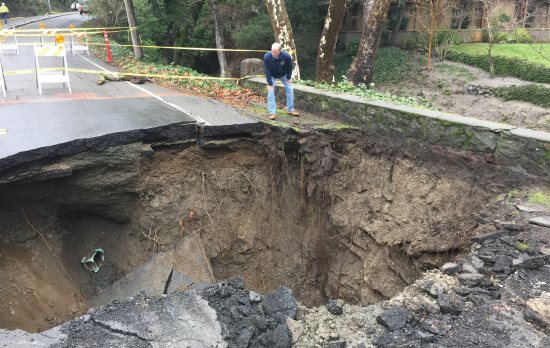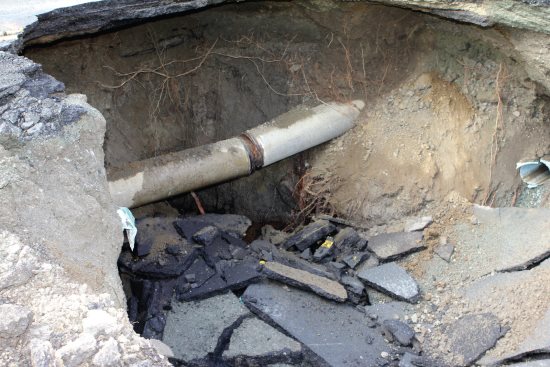| | Published January 25th, 2017
| Orinda Sinkhole Fix To Take Weeks
| | | By Sora O'Doherty |  | | State Senator and Orinda resident Steve Glazer inspects the sinkhole on Miner Road. Photo Tod Fierner |
Now it's Orinda's turn. Severe storms caused a large sinkhole on Miner Road at Camino Lanada, disrupting traffic on the busy thoroughfare. In fact, the damage was so bad that City Manager Janet Keeter recommended a local state of emergency on Jan. 12, and the city is looking at about four weeks for repairs.
 The large sinkhole was the worst of the damage inflicted on Orinda by a strong winter storm that also resulted in downed trees and utility poles, mudslides, power outages, and flooding. Further winter storms may worsen the condition of the sinkhole, and interfere with the progress of repair. While Moraga opted to wait out the rainy season before proceeding with repairs on its sinkhole, Orinda's serious situation precludes that option. Orinda hopes that a break in the weather might allow repairs to be completed in around a month. It is possible that work may continue around-the-clock. Miner Road, a heavily traveled road, had to be closed to pedestrian and vehicular traffic. In addition, utilities were impacted, including two Central Sanitary District sewer lines, a PG&E gas line, and an EBMUD water line that provides water to all of north-east Orinda.
The large sinkhole was the worst of the damage inflicted on Orinda by a strong winter storm that also resulted in downed trees and utility poles, mudslides, power outages, and flooding. Further winter storms may worsen the condition of the sinkhole, and interfere with the progress of repair. While Moraga opted to wait out the rainy season before proceeding with repairs on its sinkhole, Orinda's serious situation precludes that option. Orinda hopes that a break in the weather might allow repairs to be completed in around a month. It is possible that work may continue around-the-clock. Miner Road, a heavily traveled road, had to be closed to pedestrian and vehicular traffic. In addition, utilities were impacted, including two Central Sanitary District sewer lines, a PG&E gas line, and an EBMUD water line that provides water to all of north-east Orinda.
 The Orinda City Council met in special session on Jan. 17 to adopt a resolution declaring the emergency, and to be updated by staff on the situation. So long as the emergency resolution is in place, staff will have to provide regular updates. The resolution must be addressed at each council meeting until the issue is fully resolved.
The Orinda City Council met in special session on Jan. 17 to adopt a resolution declaring the emergency, and to be updated by staff on the situation. So long as the emergency resolution is in place, staff will have to provide regular updates. The resolution must be addressed at each council meeting until the issue is fully resolved.
 Residents near the sinkhole have been very cooperative with the city, and are willing to have work proceed round the clock to effect the repair as quickly as possible. The sinkhole has caused significant difficulties, particularly for safety transportation. The school bus route is affected and County Connection has to run smaller buses. Emergency vehicles have a more difficult time getting through the area. The fact that the gas line bypass is above ground is also concerning.
Residents near the sinkhole have been very cooperative with the city, and are willing to have work proceed round the clock to effect the repair as quickly as possible. The sinkhole has caused significant difficulties, particularly for safety transportation. The school bus route is affected and County Connection has to run smaller buses. Emergency vehicles have a more difficult time getting through the area. The fact that the gas line bypass is above ground is also concerning.
 Director of Public Works Larry Theis presented the current state of the sinkhole. The city moved swiftly: notified of the sinkhole at 8:30 a.m. on Jan. 11, the city closed the road by 8:45 a.m. Central Sanitation was the first utility to respond, bypassing the sewer lines running through the sinkhole. By early afternoon, PG&E ran a 6-inch gas bypass hose, which is running above ground in the country club golf course. Currently a large pump requires 24-hour-a-day staffing. Cowan & Thompson are onsite with heavy equipment, removing unsupported asphalt and providing detour signs.
Director of Public Works Larry Theis presented the current state of the sinkhole. The city moved swiftly: notified of the sinkhole at 8:30 a.m. on Jan. 11, the city closed the road by 8:45 a.m. Central Sanitation was the first utility to respond, bypassing the sewer lines running through the sinkhole. By early afternoon, PG&E ran a 6-inch gas bypass hose, which is running above ground in the country club golf course. Currently a large pump requires 24-hour-a-day staffing. Cowan & Thompson are onsite with heavy equipment, removing unsupported asphalt and providing detour signs.
 The council had to consider whether to perform a temporary fix or try to do the permanent repair right away. The council likes the idea of going for the permanent repair to avoid a second disruption to the community. It is possible that the repair may be done in phases. Although it is not required to do so, the city is seeking bids so that it can get ideas about methods of repair, cost and timelines. It is estimated that the project will cost approximately $1 to $1.3 million.
The council had to consider whether to perform a temporary fix or try to do the permanent repair right away. The council likes the idea of going for the permanent repair to avoid a second disruption to the community. It is possible that the repair may be done in phases. Although it is not required to do so, the city is seeking bids so that it can get ideas about methods of repair, cost and timelines. It is estimated that the project will cost approximately $1 to $1.3 million.
 The current culvert contains a 7 to 7-and-a-half-foot corrugated metal pipe, which was inspected in 2014 and recommended for rehabilitation in five years, as a moderate priority. Theis spoke of various possible replacements - corrugated metal, plastic or concrete - but recommended going to a larger, 9-foot pipe to protect against severe storms in the future. Additionally, the head walls at either end of the culvert need to be replaced, which adds a lot of expense and time to the project but is a safety issue. The exact cause of the failure will not be know until further excavation is done, and may not even be clear then.
The current culvert contains a 7 to 7-and-a-half-foot corrugated metal pipe, which was inspected in 2014 and recommended for rehabilitation in five years, as a moderate priority. Theis spoke of various possible replacements - corrugated metal, plastic or concrete - but recommended going to a larger, 9-foot pipe to protect against severe storms in the future. Additionally, the head walls at either end of the culvert need to be replaced, which adds a lot of expense and time to the project but is a safety issue. The exact cause of the failure will not be know until further excavation is done, and may not even be clear then.
 The city's goal for the repair is to keep it simple and fast. The immediate next steps include a topographical survey and geotechnical assessment, the installation of two 61-foot steel beams to secure the existing 16-inch EBMUD water main, which will be strapped to the beam at 10-foot intervals from either side, leaving an unstrapped portion of about 30 feet in the center. A pipe will need to be installed in the creek to bypass the sinkhole during upcoming storms and during construction of the new culvert.
The city's goal for the repair is to keep it simple and fast. The immediate next steps include a topographical survey and geotechnical assessment, the installation of two 61-foot steel beams to secure the existing 16-inch EBMUD water main, which will be strapped to the beam at 10-foot intervals from either side, leaving an unstrapped portion of about 30 feet in the center. A pipe will need to be installed in the creek to bypass the sinkhole during upcoming storms and during construction of the new culvert.
 Meanwhile, in Moraga
Meanwhile, in Moraga
 So far the Moraga sinkhole measures to withstand winter storms have been working well and the Town Manager Bob Priebe confirmed that his teams are monitoring what is happening at the sinkhole near the Rheem Valley Shopping Center. The town is waiting for the rainy season to end before embarking on repairs.
So far the Moraga sinkhole measures to withstand winter storms have been working well and the Town Manager Bob Priebe confirmed that his teams are monitoring what is happening at the sinkhole near the Rheem Valley Shopping Center. The town is waiting for the rainy season to end before embarking on repairs.
 The town was not able to get a confirmation from federal agencies that it would get financial support in time to start bidding the repair project before the rainy season. Therefore, it had to secure the hole and make sure that the creek that flows through the failed culvert at the crossing of Moraga Road and Rheem Boulevard would not wreak more havoc in town.
The town was not able to get a confirmation from federal agencies that it would get financial support in time to start bidding the repair project before the rainy season. Therefore, it had to secure the hole and make sure that the creek that flows through the failed culvert at the crossing of Moraga Road and Rheem Boulevard would not wreak more havoc in town.
 At this time, the town is confident that it will be ultimately reimbursed for the millions it will cost to repair the failed culvert and the intersection that collapsed as a result.
At this time, the town is confident that it will be ultimately reimbursed for the millions it will cost to repair the failed culvert and the intersection that collapsed as a result.

|
 | | Photo Gint Federas | | | | | | | | | | | |





